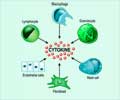Researchers from Drexel University and the University of Brighton in the U.K. have achieved groundbreaking results, which may significantly improve the treatment of sepsis.
Researchers from Drexel University and the University of Brighton in the U.K. have achieved groundbreaking results, which may significantly improve the treatment of sepsis.
Sepsis is an uncontrolled immune response to infection or severe trauma that results in 1,500 deaths worldwide every day, a scale comparable to those caused by lung and breast cancers. Sepsis occurs when proteins called cytokines are released by the immune system in response to infection and create an intense state of systemic inflammation that damages healthy tissue and can lead to organ failure. The worldwide occurrence of sepsis is approaching 20 million cases annually and the absence of efficient drug-based therapies makes this systemic inflammatory response to infection one of the major burdens of healthcare systems, costing over $17 billion per year in the U.S. alone.Sepsis can be treated by hemofiltration, but the efficiency of treatment is limited by the filter material. The most popular filter material currently in use is activated carbon (charcoal). Its ability to treat poisoning has been known for over three thousand years. It works by adsorbing small organic molecules. However, even advanced activated carbon, with a surface area over 2000 m2/g, falls short when larger biological molecules, such as proteins with characteristic dimensions, over 5-10 nm, need to be removed from the human body or biological fluids. Most of the pores in activated carbon are too small and only a small fraction of the surface area is available for adsorption. Technology for production of medical adsorbents has not changed much during the last century and only a limited control over pore size can be achieved.
The U.S./U.K. team has developed a novel method that allows the creation of carbon adsorbents with the desired size of pores. The new method uses selective etching of inorganic crystalline carbides. The formation of pores is governed by a self-assembling process.
“The beauty and power of our technology is its ability to fine-tune the carbon microstructure and pore size to target a specific application,” says Yury Gogotsi, director of the A. J. Drexel Nanotechnology Institute (DNI) and a co-inventor of the technology. Gogotsi’s team and his collaborators from Brighton, led by Sergey Mikhalovsky, tested the new adsorbents for the removal of inflammatory cytokines from blood plasma and obtained very promising results. The nano-engineered adsorbents outperformed any other materials or methods in the efficiency of cytokine adsorption, and the results are comparable only to highly specific antibody-antigen interactions. The development of these materials could be a major step toward fighting severe sepsis.
Similar materials could be used for the selective adsorption of other large organic molecules and possibly viruses for other bio-related or medical applications. “Maybe one day we will be able to apply our technology to fight Hepatitis C or bird flu or HIV,” says Dr. Gleb Yushin, research assistant professor at the Drexel Nanotechnology Institute and lead author on the journal article that reports this work.
Source-Newswise
SRM






